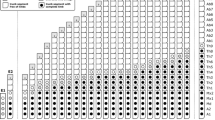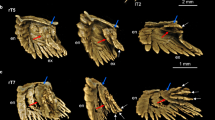Abstract
The external morphology of limb development in Orchestia cavimana is examined by scanning electron microscopy and fluorescence staining from the appearance of the first limb buds until hatching. As other amphipods, O. cavimana undergoes direct development and the degree of segmental differentiation shows a more or less continual decrease in anteroposterior direction. Limbs form ventrally as small buds, which elongate and divide into podomeres early in development. This early subdivision largely corresponds with the limb segmentation of the hatchling. When the post-naupliar limbs start to develop, the germ band begins to split into two halves along the midline, so that the trunk limbs transiently occupy a very dorsolateral position. After the germ band has closed again, the differentiation into the characteristic amphipodan tagmata (cephalothorax, pereon, pleon) takes place and the limb podomeres lose their round-shape. The late embryo is covered by a so-called intermediate cuticle, which is formed after an embryonic moult and shed after hatching. The early development of O. cavimana reveals the Anlage of a vestigial seventh pleonic segment that is assumed to belong to the ground pattern of malacostracans, but is retained as a free, limbless segment only in adult Leptostraca. A transient subdivision of the proximal segment of the pleopods suggests the occurrence of a coxa and a basis in these limbs. The mandible attains its upright, adult position via a characteristic bending process that is strikingly similar to that in Archaeognatha (Insecta).








Similar content being viewed by others
References
Abzhanov A, Kaufman TC (2000) Homologs of Drosophila appendage genes in the patterning of arthropod limbs. Dev Biol 227:673–689
Dahl F (1942) Krebstiere oder Crustacea, IV: Flohkrebse oder Amphipoda. In: Schellenberg A (ed) Die Tierwelt Deutschlands, vol 40. Gustav Fischer Verlag, Jena, pp 1–252
Dahl E (1992) Aspects of malacostracan evolution. Acta Zool 73:339–346
Dohle W, Scholtz G (1988) Clonal analysis of the crustacean segment: the discordance between genealogical and segmental borders. Dev Suppl 104:147–160
Dohle W, Scholtz G (1997) How far does cell lineage influence cell fate specification in crustacean embryos? Cell Dev Biol 8:379–390
Dohle W, Gerberding M, Hejnol A, Scholtz G (2004) Cell lineage, segment differentiation, and gene expression in crustaceans. In: Scholtz G (ed) Crustacean issues 15, evolutionary developmental biology of Crustacea. Balkema, Lisse, pp 95–133
Gerberding M, Scholtz G (1999) Cell lineage of the midline cells in the amphipod crustacean Orchestia cavimana (Crustacea, Malacostraca) during formation and separation of the germ band. Dev Genes Evol 209:91–102
Gerberding M, Scholtz G (2001) Neurons and glia in the midline of the higher crustacean Orchestia cavimana are generated via an invariant cell lineage that comprises a median neuroblast and glial progenitors. Dev Biol 235:397–409
Gilbert SF (1997) Chapter 13. Arthropods: the crustaceans, spiders, and myriapods. In: Gilbert SF, Raunio AM (eds) Embryology. Sinauer Associates, Sunderland, pp 237–258
Graf F, note transmise par Grassé P-P (1972) Stockage de calcium et formation des soies chez l’embryon d’ Orchestia (Crustacé, Amphipode, Talitridé). Notion d’intermue embryonnaire. C R Acad Sc Paris 275:1669–1672
Gruner HE (1993) 1. Klasse Crustacea. In: Gruner HE (ed) Lehrbuch der speziellen Zoologie. Band 1: Wirbellose Tiere. 4. Teil: Arthropoda (ohne Insecta). Gustav Fischer Verlag, Jena, pp 448–1030
Hansen HJ (1925) Studies on Arthropoda II. On the comparative morphology of the appendages in the Arthropoda. A Crustacea. Copenhagen Gyldendalske Boghandel. Kopenhagen, London, Berlin, pp 1–176
Hejnol A, Scholtz G (2004) Clonal analysis of Distal-less and engrailed expression patterns during early morphogenesis of uniramous and biramous crustacean limbs. Dev Genes Evol 214(10):473-485
Hickman VV (1937) The embryology of the syncarid crustacean, Anaspides tasmaniae. Proc Roy Soc Tasmania 1–35
Lauterbach K-E (1975) Über die Herkunft der Malacostraca (Crustacea). Zool Anz 194:165–179
Machida R (2000) Serial homology of the mandible and maxilla in the jumping bristletail Pedetontus unimaculatus Machida, based on external embryology (Hexapoda: Archaeognatha, Machilidae). J Morphol 245:19–28
Manton SM (1928) On the embryology of a mysid crustacean, Hemimysis lamornae. Philos Trans R Soc Lond (B) 216:363–463
Meschenmoser M (1987) Zur Embryonalentwicklung von Orchestia cavimana Heller 1865 (Crustacea, Amphipoda) unter besonderer Berücksichtigung des Dorsalorgans. Diplomarbeit, Westfälische-Wilhelms-Universität Münster
Olesen J, Walossek D (2000) Limb ontogeny and trunk segmentation in Nebalia species (Crustacea, Malacostraca, Leptostraca). Zoomorphology 120:47–64
Prpic N-M, Tautz D (2003) The expression of the proximodistal axis patterning genes Distal-less and dachshund in the appendages of Glomeris marginata (Myriapoda: Diplopoda) suggests a special role of these genes in patterning the head appendages. Dev Biol 260:97–112
Prpic N-M, Wigand B, Damen WGM, Klingler M (2001) Expression of dachshund in wild-type and Distal-less mutant Tribolium corroborates serial homologies in insect appendages. Dev Genes Evol 211:467–477
Richter S, Scholtz G (2001) Phylogenetic analysis of the Malacostraca (Crustacea). J Zool Syst Evol Res 39:113–136
Scholl G (1963) Embryologische Untersuchungen an Tanaidaceen (Heterotanais oerstedi Kröyer). Zool Jb Anat 80:500–545
Scholtz G (1990) The formation, differentiation and segmentation of the post-naupliar germ band of the amphipod Gammarus pulex L. (Crustacea, Malacostraca, Peracarida). Proc R Soc Lond B 239:163–211
Scholtz G (1995) Expression of the Engrailed gene reveals nine putative segment-anlagen in the embryonic pleon of the freshwater crayfish Cherax destructor (Crustacea, Malacostraca, Decapoda). Biol Bull 188:157–165
Scholtz G (2000) Evolution of the nauplius stage in malacostracan crustaceans. J Zool Syst Evol Res 38: 175–187
Scholtz G, Dohle W (1996) Cell lineage and cell fate in crustacean embryos - a comparative approach. Int J Dev Biol 40:211–220
Scholtz G, Wolff C (2002) Cleavage, gastrulation, and germ disc formation of the amphipod Orchestia cavimana (Crustacea, Malacostraca, Peracarida). Contrib Zool 71:9–28
Scholtz G, Mittmann B, Gerberding M (1998) The pattern of Distal-less expression in the mouthparts of crustaceans, myriapods and insects: new evidence for a gnathobasic mandible and the common origin of Mandibulata. Dev Biol 42:801–810
Schram FR (1986) Crustacea. Oxford Unviersity Press, New York, Oxford, pp 1–606
Shiino SM (1942) Studies on the embryology of Squilla oratoria de Haan. Mem Coll Sci Kyoto Imp Univ B 17:77–174
Strömberg JO (1967) Segmentation and organogenesis in Limnoria lignorum (Rathke) (Isopoda). Ark Zool 20:145–179
Thiele J (1905) Betrachtungen über die Phylogenie der Crustaceenbeine. Z Wiss Zool 82:445–471
Walossek D (1999) On the Cambrian diversity of Crustacea. In: Schram FR, von Vaupel Klein JC (eds) Crustaceans and the biodiversity crisis. In: Proceedings of the 4th International Crustacean Congress, Amsterdam, The Netherlands, July 20–24, 1998, vol. 1, Brill Academic Publishers, Leiden, pp 3–27
Walossek D (2003) Cambrian ‘Orsten’-type arthropods and the phylogeny of Crustacea. In: Legakis A et al eds. The new panorama of animal evolution. In: Proceedings of the 18th international congress of Zoology, Athens, Pensoft Publishers, Sofia, Moscow, pp 67–84
Weygoldt P (1958) Die Embryonalentwicklung des Amphipoden Gammarus pulex pulex (L.). Zool Jb Anat 77:51–110
Wolff C, Scholtz G (2002) Cell lineage, axis formation, and the origin of germ layers in the amphipod crustacean Orchestia cavimana. Dev Biol 250:44–58
Acknowledgements
We are very grateful to G. Drescher of the Institute of Systematic Zoology of the Natural History Museum, Berlin, for support using the SEM. Prof. Gerhard Scholtz spent valuable time going through the manuscript, which is gratefully acknowledged. We thank S. Richter for helpful discussions. Many thanks also to P. T. Graham for improving the English.
Author information
Authors and Affiliations
Corresponding author
Rights and permissions
About this article
Cite this article
Ungerer, P., Wolff, C. External morphology of limb development in the amphipod Orchestia cavimana (Crustacea, Malacostraca, Peracarida). Zoomorphology 124, 89–99 (2005). https://doi.org/10.1007/s00435-005-0114-2
Received:
Accepted:
Published:
Issue Date:
DOI: https://doi.org/10.1007/s00435-005-0114-2




